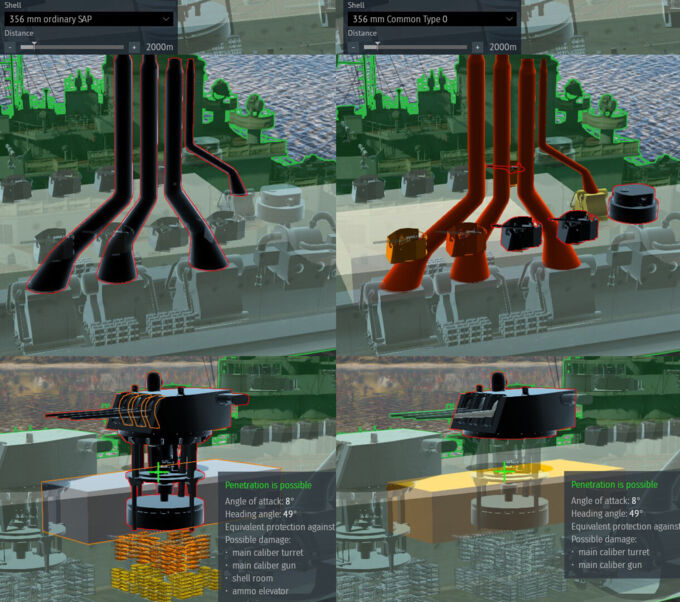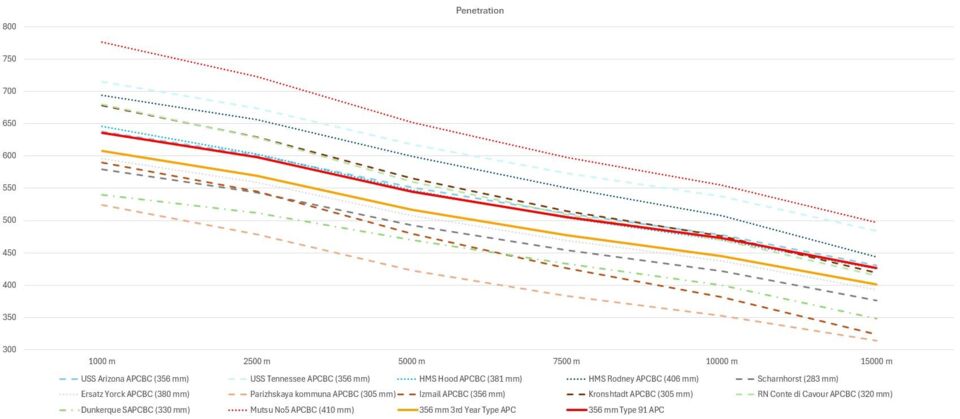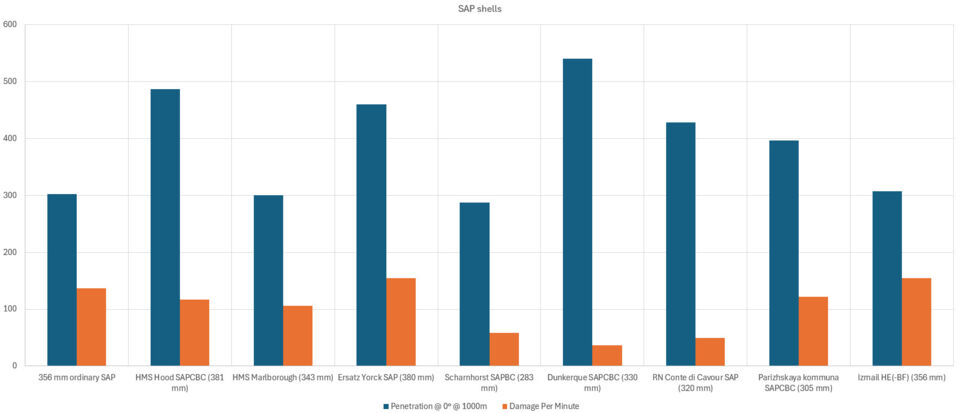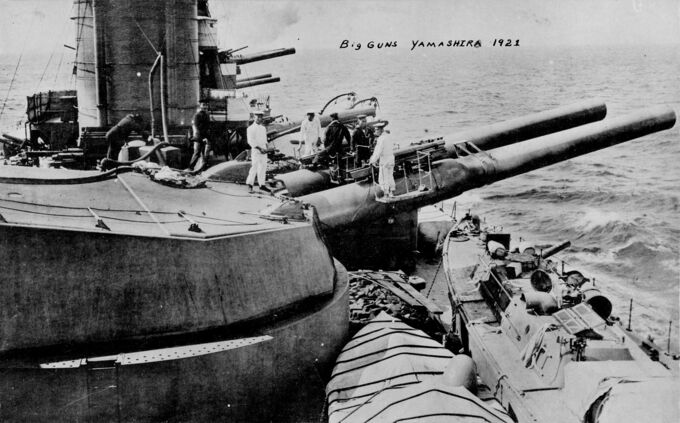The 36 cm/45 Type 41 is a Japanese 356 mm naval cannon commonly found on many of the nation’s battleships. It is a highly capable primary gun, often able to eliminate enemy destroyers or light cruisers with a single broadside. It also offers a wide selection of ammunition and a few slightly different turret designs.
| Advantages | Disadvantages |
|---|---|
| Good, high-velocity SAP shell | Extremely lacklustre HE shell, featuring one of the smallest explosive fillers and lowest muzzle velocities, making it highly situational. |
| Good penetration of the AP shell with a more flat penetration curve at range than the contemporaries | Dedicated armour-piercing shell, while it offers above-average penetration, it has one of the smallest explosive fillers among its peers, resulting in very poor after-penetration damage. |
| Large shells make for huge holes in the enemy ships, speeding up flooding and making unwatering longer, making it common to sink ships via flooding, especially destroyers and light cruisers | No dedicated anti-air shells |
Table of contents:
- Ammunition
- Variations — differences between 36 cm/45 Type 41 on different ships
- Comparison with analogues — numerical analysis
- Usage in battles — summary from an in-game perspective POV
- History — development, shell types, etc.
- External links — sources for History and other relevant websites
Ammunition
There are 4 types of shells available:
- 356 mm ordinary SAP — the default shell, is most useful of the three, having the largest bursting charge while also maintaining good penetration capabilities and one of the best muzzle velocities in its class. It is able to deal with most targets, delivering an abundance of damage. It struggles against battleships or otherwise heavily armoured parts of warships (turret faces, armoured magazines, etc.).
- APC shells (Type 91 / 3rd Year Type) — a perfect choice for dealing with battleships or more heavily armoured and/or angled battlecruisers. What they lack in explosive filler, they make up for in penetration. Generally, it shouldn’t be used against lightly armoured targets, as the damage output is rather inadequate. Older 3rd Year Type APC shells have about 30 mm less penetration, but in most engagements, it makes no difference.
- Common Type 0 HE — an oddity among warships, where the HE shell has significantly less explosive filler than the SAP shell. Given that SAP has a fuse of just 12 mm it leaves HE only for the least armoured targets, such as destroyers (which likely would be better dealt with using the secondary guns) or taking out exposed emplacements like unarmoured secondary and anti-aircraft guns.
Variations
The gun comes in several variations. While the visual differences are minimal, making the turrets nearly indistinguishable, the most significant variation lies in the armour scheme. The table below is simplified but should provide a clear understanding of the key differences.
| Front | Side | Top | Barbette | |
|---|---|---|---|---|
| Hyuga | 305 mm RCA @ 17° | 203 mm RCA @ 15° | 115 mm RHA | 299-100 mm RCA |
| Kongo Haruna Kirishima | 254 mm RCA @ 25° | 254 mm RCA @ 13° | 152 mm RCA | 229-76 mm RCA |
| Fuso | 279 mm RCA @ 17° | 229 mm RCA @ 15° | 114 mm RHA | 305-102 mm RCA |
| Yamashiro | 279.4 mm RCA @ 17° | 228.6 mm RCA @ 15° | 76.2 mm RCA | 304.8-76.2 mm RCA |
| Ise | 305 mm RCA @ 17° | 203 mm RCA @ 15° | 115 mm RHA | 300-50 mm RCA |
As you can observe in-game, RCA is superior to RHA. For instance, on Hyūga, the 115 mm RHA turret top armour translates to 'equivalent protection against specific ammo' of 115 mm @ 0° angle of attack. In contrast, the 305 mm RCA of the turret face translates to 337 mm, implying a ×1.105 multiplier.
One important detail regarding the differences in armour protection is that Ise features multi-layered armour on the barbettes. For example, the base of the barbettes is 100 mm RCA, similar to Hyūga, but with an additional 158 mm RCA plating on top.
Choice of ammunition
Vessels also have varying access to shells. Generally, more modern refits have access to more advanced AP shell types and additional HE shells, while the 1920s refits lack HE and are equipped with the 3rd Year Type APC shells.
Comparison with analogues
In this section, we will delve into the technical details of how the 36 cm/45 Type 41 compares to selected guns on warships of other nations within this BR range. This is a numerical analysis that may be meaningless or misleading without a deeper understanding of gameplay mechanics. If you prefer, feel free to skip directly to the Usage in Battles section for conclusions.
For the first chart, we will examine the penetration characteristics of the 36 cm/45 Type 41, specifically focusing on the two armour-piercing shells available: the 3rd Year Type APC (orange) and the Type 91 APC (red solid line).
The shells can be best described as average, with the penetration at 1,000 metres and 0° angle of attack being slightly below average for the 3rd Year Type and slightly above average for the Type 91.
Interestingly, these shells retain a lot of energy over range, with the Type 91 ranking in the top five of the shells listed at ranges significantly beyond 10 km. It outperforms the results of Izmail's 14-inch/52 Pattern 1913 and even the 320 mm/44 OTO guns found on the RN Conte di Cavour’s and RN Duilio, both of which have exceptional characteristics for 14-inch and 12.5-inch guns, respectively. The only 14-inch gun that remains notably ahead is the 14-inch L/50 Mk. 11 battery of the USS Tennessee and USS Mississippi, though these ships are in a league of their own.
It is also worth mentioning that the 36 cm/45 Type 41 with Type 91 shells has equal or superior penetration compared to some much higher-calibre guns, most notably the German 38 cm/45 SK L/45 found on the Ersatz Yorck and Bayern-class battleships.
Of course, penetration of AP shells is not the only factor to consider, accuracy and damage potential (the average amount of TNT equivalent the gun can deliver per minute) are also crucial.
In these areas, the 36 cm/45 Type 41 performs below average.
While it can easily outmatch US battleships in damage output while maintaining the same accuracy, Soviet vessels are far ahead, making it no competition. For example, Izmail sacrifices about 8% of penetration for a 78% increase in potential damage per minute, all while retaining the same accuracy. Additionally, Izmail boasts a 12-gun broadside, matching Japanese battleships and significantly surpassing the 8-gun broadside of the Kongō-class.
HE & SAP
While AP shells are typically the most important for battleship engagements, the other two shell types, HE and SAP, also play significant roles.
In terms of HE shells, the Type 0, with its 32.45 kg filler, is one of the weakest among its peers. American, British, German, and Soviet equivalents all feature superior fillers.
Among SAP shells, it’s much more competitive:
The gun has an impressive damage output for the SAP shells, with only two ships having a significant damage advantage: Ersatz Yorck and Izmail (Izmail’s rounds are designated as HE in-game, but they function identically to SAP). On the other hand, penetration numbers are either average or perhaps even below-average, if you account for British and German 380 mm shells.
Overall, the SAP shells have good performance, being capable of out-damaging most vessels in the BR 6.7 to 7.0 range.
Usage in battles
Usage of the 36 cm/45 Type 41 is no different than most of the other high-calibre main guns on battlecruisers and battleships. The only feature of note are the lacklustre HE shells that should be avoided outside of igniting fires on the enemies or dealing with coastal vessels. Overall though the gun is perfectly adequate, there’s no point in which it stands out above all its peers, but there’s also nothing where it’s extraordinarily lacklustre.
- Battleships of the top tier are to be dealt with using AP shells, but battleships in BR 6.3 and below can often still be effectively countered with SAP shells, if not directly to the broadside, then by attacking from bow or stern angles.
- Battlecruisers in the top tier have very varied armour, making some of them penetrable with SAP shells, while others, in favourable conditions, will happily bounce AP. For example, Ersatz Yorck can be penetrated with SAP shells into the magazines from around 10 kilometres, Repulse can be ammo-racked with SAP hitting bow or stern from any range and angle, while Hood will never suffer any serious direct damage without the use of AP shells.
- Cruisers and Destroyers are best dealt with using SAP shells. Range or angle is rarely a factor in determining whether the target will be penetrated or not, with rare exceptions such as Zaras and Admiral Hippers. A single broadside of HE shells can be added to the mix if you aim to destroy the vessel by depleting its crew.
- Coastal vessels are typically best dealt with using HE shells, as you do not have to worry about overpenetration, and the large explosive filler will still inflict substantial damage.
There are two exceptions to this rule where using SAP shells is beneficial: heavily armoured coastal vessels (e.g. MBK 161) or approaching/departing frigates (like the SKR-7), where you can shoot directly into the bow or stern of the vessel, making the SAP shells explode deep within the hull.
- Aircraft should be avoided. Instead, use secondary or anti-air
guns to counter them. If desperate, HE shells will give you better
results.
History
The 45-calibre 41 Type 36 cm Gun (45口径四一式36cm砲) was the main gun famously used on the Kongō-class battlecruisers along with the Ise and Fusō-class battleships. It shared a piece of history with the 50-calibre 41 Type 15 cm Gun, being originally introduced with the Kongō battlecruiser, at the time the highest calibre naval guns in service of any country in the world. First units were manufactured in the UK by Vickers, while the remaining was constructed at the Kure Naval Arsenal, for a total of over 100 guns of the type being built until the end of World War 2.
Being widely used type of gun, they have seen a number of modifications and modernisations over their lifetime.
During the inter-war period gun turrets were modified to increase the elevation from 33° to 43°. It was achieved by reconstructing the gunwell and lowering the revolving part of the turret’s structure. This upgrade was completed for all ships with the Type 41 guns except for the aft-most guns on Ise and Hyūga, until both were eventually rebuilt to hybrid carriers, thus removing the problematic gun turrets.
Other upgrades included a new, double, longitudinal flashtight bulkheads separating the two guns in the turret or a new loading cages allowing a full set of charges to be loaded in a single stroke of the power rammer. Additionally in December 1937 an experimental sprinkler system was added to the battleship Ise, decreasing the risk of fire and catastrophic explosion.
The 36 cm gun weighted 86 tonnes (for a total weight of 699 t (Ise-type) or 664 t (Haruna-type) turrets) and could fire shells with a muzzle velocity of 770 to 805 m/s (depending on the mass of the shell) up to 35,500 m away or 9,750 m altitude (for anti-air duty).
Shells
The 36 cm Type 41 used several different shell types over its lifespan. Most of the development was focused on the armour-piercing shells, which were supplemented by two types of high explosive rounds, and, during the WW2, the Sanshikidan shells.
Armour-piercing
- Type 3 APC — Armour-piercing shell, officially adopted into service in 1917. It’s marked after the year Taishō 3 (or 1914 Gregorian calendar).
- Type 5 APC — An upgrade of the Type 3 shell using the lessons learnt for the German and British shells purchased by the Japanese after the Great War. Type 5 was officially adopted into service in 1925, designated after Taishō 5 (1916 Gregorian calendar). It used an 0.2-sec delay Type 13 Mark 3 Short Delay Fuse.
- No. 6 APC — Adopted in 1928 was a further upgrade to the Type 5, it improved the shell behaviour below the water surface, improving the penetration below the water line, and decreased the probability of premature detonation.
- Type 88 APC — Had no changes in relation to No. 6, it’s just a redesignation made in 1931.
- Type 91 APC — A new type of the shells introduced in 1931. Over time it completely replaced older types of the armour-piercing rounds. It used the 0.4-sec delay, Type 13 Mark 4 base fuse and Type 13 Mark 4 Mod 1 base fuse (modification decrease the probability of a fuse failure), in 1941 a new 0.4-sec delay Type 13 Mark 5 fuse was added. Number 91 stands for the 2591 Japanese Imperial year, which translates to 1931 in Gregorian calendar.
- Type 1 APC — The last type of the armour-piercing shell used by the Type 41 guns. It was based on the Type 91, with added option to include a special dye that colored the splashes of the naval artillery. This allowed different warships to fire at the same target and still visually distinguish hit locations from different ships, even if the splashes were from the same caliber of the guns at the same time. Kongô used red dye, Haruna used black, while Hyuga never used one.
High-explosive and incendiary
- Common Projectile Type 3 HE (also known simply as “Common Capped”) — was the shell type used by Japanese during the World War 1, being derived from the imported British shells. It was officially adopted into service in 1915 and has seen decades of use in the Japanese fleet being only replaced by WW2.
- Common Projectile Type 0 HE — filled with 65.1 lb (29.5 kg) of trinitroanisole (Type 91 explosive). Shell could be equipped in one of the fuses: Type 4 Mod.1 (Mechanical Time Fuse), Type 0 (Mechanical Time Fuse), or nose contact fuse.
- Common Projectile Model 3 (sometimes confusingly referred to as a “Type 3”) — Sanshikidan incendiary/anti-aircraft shell. Each shell carried 735 incendiary tubes and 375 stays that when exploded dispersed them in 15° cone over 213 m. While being truly spectacular their real combat effectiveness was marginal at best.
Practice
An additional set of practice shells was built for the training exercises:
- Practice — from a converted WW-1 era high explosive shell
- Type 91 Practice — converted Type 91 APC
- Type 0 Practice — converted Type 0 HE
External links
Sources
- U.S. Naval Technical Mission to Japan Report O-47(N)-1 — Japanese Naval Guns and Mounts Under 18”
- U.S. Naval Technical Mission to Japan Report O-19 — Japanese Projectiles, General Types
- U.S. Naval Technical Mission to Japan Report O-17 — Japanese Naval Projectile Fuzes
- [Google Play] Handbook of Japanese Explosive Ordnance: Opnav 30-3M. 15 August 1945






